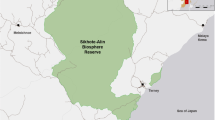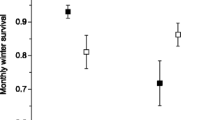Abstract
Since the Pleistocene, Arctic foxes, Alopex lagopus, on Mednyi Island in the North Pacific have been isolated in a small area with rich food resources and no other terrestrial carnivores. This situation provides an unusually simple system within which the effect of food dispersion on demography and social organisation was examined. We studied the composition, location and dispersal of 67 Arctic fox groups and mapped their major food resources (seabird colonies) during 1994–2000 on Mednyi. We compared our observations with the predictions of models of sex-ratio determination. Our observations are most consistent with the predictions of Julliard's (2000) model, where mothers are expected to produce more offspring of the most dispersing sex in low-quality habitats, and more offspring of the most philopatric sex in high-quality habitats. The polygynous foxes on Mednyi Island lived where the principal food resources were patchily distributed (present on 11% of the shoreline), and cub survival to dispersal age or reproductive adult was higher in rich (25/45) than in poor (24/79) home ranges. Furthermore, dispersal was strongly sex-biased: most females (60%) remained on their natal ranges, whereas very few males (9%) did so. Significantly more female than male cubs (54 compared with 24) emerged from dens in resource rich ranges, whereas the sex ratio on poor ranges was approximately equal (51 females and 56 males). While our observations are also to some extent consistent with the local resource enhancement (LRE) hypothesis (which predicts a bias towards the sex most likely to cooperate with parents), this does not account for the observed spatial variability.




Similar content being viewed by others
References
Angerbjörn A, Hersteinsson P, Tannerfeldt M (2004) Arctic foxes. In: Macdonald DW, Sillero-Zubiri C (eds) The biology and conservation of canids. OUP, Oxford, pp 163–172
Artyukhin B Ju (1999) The sea bird colonies on Commander Islands. In: Gerasimov N Jr (ed) Biology and conservation of Kamchatka [in Russian]. Moscow State Pages, University of Moscow, Moscow, Russia, pp 25–35
Bacon PJ, Ball F, Blackwell P (1991) A model for territory and group formation in a heterogeneous habitat. J Theor Biol 148:445–468
Burdin AM, Vertjankin VV, Nikulin VS, Fomin VV (1991) Current state of Commander common seal population. In: Popov LA (ed) Science researching of sea mammals on North Pacific in 1989–1990 [in Russian]. VNIRO, Moscow, pp 82–94
Cameron EZ (2004) Facultative adjustment of mammalian sex ratios in support of the Trivers–Willard hypothesis: evidence for a mechanism. Proc R Soc Lond B 271:1723–1728
Carr GM, Macdonald DW (1986) The sociality of solitary foragers: a model based on resource dispersion. Anim Behav 34:1540–1549
Charnov EL, Bull JJ (1977) When is sex environmentally determined? Nature 266:828–830
Clark AB (1978) Sex ratio and local resource competition in a prosimian primate. Science 201:163–165
Chelnokov FG (1970) Relationship between Arctic fox and fur seal pups. Geogr Kamchatka 6:51–58
Creel SR, Macdonald DW (1995) Sociality, group size, and reproductive suppression among carnivores. Adv Stud Behav 24:203–257
Eide NA, Jepsen JU, Prestud P (2004) Spatial organization of reproductive Arctic foxes Alopex lagopus: responses to changes in spatial and temporal availability of prey. J Anim Ecol 73:1056–1068
Emlen ST, Emlen JM, Levin SA (1986) Sex-ratio selection in species with helpers-at-the-nest. Am Nat 127:1–8
Frafjörd K (1992) Denning behaviour and activity of Arctic fox Alopex lagopus pups: implications of food availability. Polar Biol 12:707–712
Frommolt KH, Kruchenkova EP, Russig H (1997) Individuality of territorial barking in Arctic foxes. Z Säugetierkd 62:66–70
Frommolt KH, Goltsman ME, Macdonald DW (2003) Barking foxes, Alopex lagopus: field experiments in individual and group recognition in a territorial mammal. Anim Behav 65:509–518
Garrott RA, Eberhardt LE (1987) Arctic fox. In: Novak M, Baker JA, Obbard ME, Malloch B (eds) Wild furbearer management and conservation in North America. Ministry of Natural Resources, Ontario, pp 394–406
Geffen ER, Hefner DW, Macdonald DW, Ucko M (1992) Habitat selection and home range in the Blanford's fox, Vulpes cana: compatibility with the resource dispersion hypothesis. Oecologia 91:75–81
Geffen ER, Gompper ME, Gittleman JL, Luh HK, Macdonald DW, Wayne RK (1996) Size, life-history traits, and social organization in the Canidae: a reevaluation. Am Nat 147:140–160
Geptner VG, Naumov NP (1967) Mammals of the USSR, Part 1 [in Russian]. Vyschaj Skola, Moscow
Goltsman ME, Kruchenkova EP, Macdonald DW (1996) The Mednyi Arctic foxes: treating a population imperilled by disease. Oryx 30:251–258
Gould SJ, Eldredge N (1977) Punctuated equilibria: the tempo and mode of evolution reconsidered. Paleobiology 3:115–151
Greenwood PJ (1980) Mating systems, philopatry and dispersal in birds and mammals. Anim Behav 28:1140–1162
Hersteinsson P, Macdonald DW (1982) Some comparisons between red and Arctic foxes, Vulpes vulpes and Alopex lagopus, as revealed by radio tracking. Symp Zool Soc Lond 49:259–289
Hewison AJM, Gaillard JM (1999) Successful sons or advantaged daughters? The Trivers–Willard model and sex-biased maternal investment in ungulates. Trends Ecol Evol 14:229–234
Johnson DPP, Macdonald DW, Kays R, Blackwell PG (2003) Response to Revilla, and Buckley and Ruxton: the resource dispersion hypothesis. Trends Ecol Evol 18:381–382
Julliard R (2000) Sex-specific dispersal in spatially varying environments leads to habitat-dependent evolutionarily stable offspring sex ratios. Behav Ecol 11:421–428
Kartashev NN (1961) The birds on Commander Islands and rational management [in Russian]. Zool Zh 10:1395–1409
Kruchenkova EP (1991) Ontogeny of social behaviour and parent–offspring relations in the Arctic fox. PhD Thesis, Moscow State University, Moscow, Russia
Kruchenkova EP, Goltsman ME (1994) Parental behaviour of Arctic foxes in Mednyi Island [in Russian]. Zool Zh 73:88–103
Kruuk H (1978) Foraging and spatial organisation of the European badger, Meles meles L. Behav Ecol Sociobiol 4:75–89
Kruuk H, Parish T (1982) Factors affecting population density, group size and territory size of the European badger, Meles meles. J Zool (London) 196:31–39
Lehner PN (1996) Handbook of ethological methods. Cambridge University Press, Cambridge
Macdonald DW (1983) The ecology of carnivore social behaviour. Nature 301:379–384
Macdonald DW, Creel S, Mills MGM (2004a). Canid society. In: Macdonald DW, Sillero-Zubiri C (eds) The biology and conservation of canids. Oxford University Press, Oxford, pp 86–106
Macdonald DW, Creel S, Mills MG (2004b) Society. In: Macdonald DW, Sillero-Zubiri C (eds) The biology and conservation of canids. Oxford University Press, Oxford
Macdonald DW, Carr GM (1989) Food security and the rewards of tolerance. Special Publication of the British Ecological Society 8:75–99
Macdonald DW, Moehlman PD (1982) Cooperation, altruism, and restraint in the reproduction of carnivores. In: Bateson P, Klopfer P (eds) Perspectives in Ethology, vol. 5. Plenum Press, New York, pp 433–467
Marakov CV (1964) Mammals and birds of the Commander Islands [in Russian]. PhD Thesis, Moscow, Kirov-Moscow
Mayr E (1963) Animal species and evolution. Harvard University Press, Cambridge, MA
Mills MGL (1989) The comparative behavioral ecology of hyenas: the importance of diet and food dispersion. In: Gittleman JL (ed) Carnivore behavior, ecology, and evolution. Cornell University Press, Ithaca, New York, pp 125–139
Mills MGL, Gorman ML (1997) Factors affecting the density and distribution of wild dogs in the Kruger National Park. Conserv Biol 11:1397–1406
Naumov NP, Goltsman ME, Kruchenkova EP, Ovsijnikov NG, Smirin VM (1981) Social behaviour of Arctic fox on the Mednyi Island. In: Naumov NP (ed) Ecology, population organization and communicative processes in the mammals [in Russian]. Nauka, Moscow, pp 31–75
Ognev SI (1931) Mammals of the Eastern Europe and Northern Asia, vol. 2. Glavnauka, Moscow-Leningrad [in Russian]
Ovsjanikov NG (1993) The behaviour and social organization in Arctic foxes. ZNIL, Glavokhoty, Moscow [in Russian]
Patterson BR, Messier FS (2001) Social organization and space use of coyotes in Eastern Canada relative to prey distribution and abundance. J Mammal 82:463–477
Ponomareva EO, Isachenkova LB (1991) The main physico-geographical features of the Commander Islands. In: Solokov VE (ed) Natural resources of the Commander Islands [in Russian]. Moscow State University, Moscow, pp 17–29
Pusey AE (1987) Sex-biased dispersal and inbreeding avoidance in birds and mammals. Trends Ecol Evol 2:295–299
SAS Institute Inc (1990) SAS.STAT User's Guide, Version 6, 4th ed. SAS Institute, Cary, NC
Sheldon BC, West SA (2004) Maternal dominance, maternal condition, and offspring sex-ratio in ungulate mammals. Am Nat 163:40–54
Shilajeva LM (1967) Studying the migration of the Arctic fox [in Russian]. Prob North 11:103–112
Silk JB (1983) Local resource competition and facultative adjustment of sex ratios in relation to competitive activities. Am Nat 130:56–66
Strand O, Landa A, Linnell JDC, Zimmermann B, Skogland T (2000) Social organization and parental behavior in the Arctic fox. J Mammal 81:223–233
Tannerfeldt M, Angerbjörn A (1998) Resource fluctuations and the evolution of litter size in the Arctic fox. Oikos 83:545–559
Trivers RL, Willard DE (1973) Natural selection of parental ability to vary the sex ratio of offspring. Science 179:90–92
Valenzuela DG, Macdonald DW (2002) Home range use by white-nosed coatis (Nasua narica): limited water and a test of the resource dispersion hypothesis. J Zool 258:247–256
Vertjankin VV, Nikulin VS, Fomin VV (1991) State of Commander sea otter population in 1990. In: Popov LA (ed) Science researching of sea mammals on North Pacific in 1989–1990 [in Russian]. VNORO, Moscow, pp 216–222
Vladimirov VA (1991) Basic biostatistic parameters of fur seal populations in USSR in 1958–1990. In: Popov LA (ed) Science researching of sea mammals on North Pacific in 1989–1990 [in Russian]. VNORO, Moscow, pp 165–179
Wolff JO (1993) What is the role of adults in mammalian juvenile dispersal? Oikos 68:173–176
Wolff JO, Plissner JH (1998) Sex bias in avian natal dispersal—an extension of the mammalian model. Oikos 83:327–330
Woodroffe R, Macdonald DW (1993) Badger sociality – models of spatial grouping. Symp Zool Soc Lond 65:145–169
Zabel CJ, Taggart SJ (1989) Shift in red fox, Vulpes vulpes, mating system associated with El Ninõ in the Bering Sea. Anim Behav 38:830–838
Zagrebelnii SV (2000) Ecology of feeding in Bering (Alopex lagopus beringensis) and Mednyi (A.l. semenovi) Arctic foxes (Carnivora, Canidae) from Commander Islands [in Russian]. Zool Zh 79:595–607
Zalkin VI (1944) Geographical variability in the skull structure of the Eurasian polar fox [in Russian]. Zool Zh 23:156–169
Zar JH (1999) Biostatistical analysis, 4th edn. Prentice-Hall, London
Acknowledgments
The study would not have been possible without the long-term logistical support and organisational help of Aleksandr Aboliz, Aleksandr Boltnev, Aleksandr Burdin and Vladimir Burkanov. The following have contributed to data collection: Ilija Volodin, Alexey Zimenko, Evgeny Mamaev, Dmitry Glazov, Ekaterina Vorobieva, Anna Goltsman, Filip Nagornev, Olga Filatova, Karl-Heinz Frommolt, Antje Jakupi and Ekaterina Jikia. We are grateful to Vladimir Vertjankin, Vladimir Fomin, Sergey Zagrebelnyi and Aleksandr Stegaro for their assistance and help in the field. For advice and helpful comments, we are grateful to Dominic Johnson and Morris Gosling. The manuscript also benefited greatly from the input of Donald Strong, Ruth Cox and Dominique Berteaux. We are particularly grateful to Marco Festa-Bianchet for two thoughtful reviews at different stages of the development of this manuscript. The surveys were financed by the Actual Biology Foundation (Russia), Russian Foundation of Basic Sciences, the International Science Foundation, the John D. and Catherine T. MacArthur Foundation, Fauna & Flora Preservation Society (UK), Peoples' Trust for Endangered Species (UK), Tusk Force (UK) and INTAS. Since 1994 this project has been under the auspices of the IUCN/SSC Canid Specialist Group. The study was carried out under license (N UL-17-2881) from the Russian Federation Ministry of Regional Policy, and the Russian Federation National Committee of Nature Conservation and the Commander Island Nature Reserve. Animals were tagged with permission from the Russian Federation National Committee of Nature Conservation (license N0000209) and the Commander Island Nature Reserve
Author information
Authors and Affiliations
Corresponding author
Additional information
Communicated by M. Festa-Bianchet
Rights and permissions
About this article
Cite this article
Goltsman, M., Kruchenkova, E.P., Sergeev, S. et al. Effects of food availability on dispersal and cub sex ratio in the Mednyi Arctic fox. Behav Ecol Sociobiol 59, 198–206 (2005). https://doi.org/10.1007/s00265-005-0025-8
Received:
Revised:
Accepted:
Published:
Issue Date:
DOI: https://doi.org/10.1007/s00265-005-0025-8




